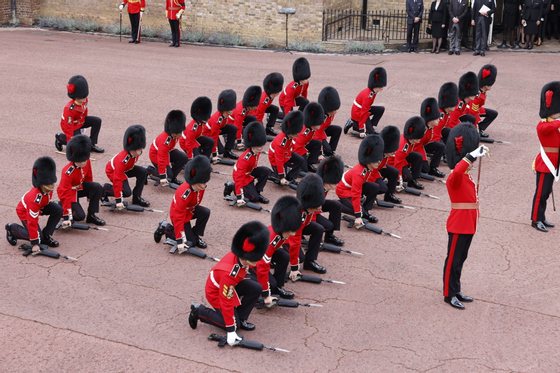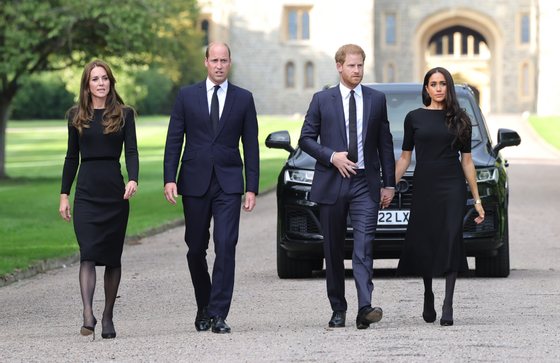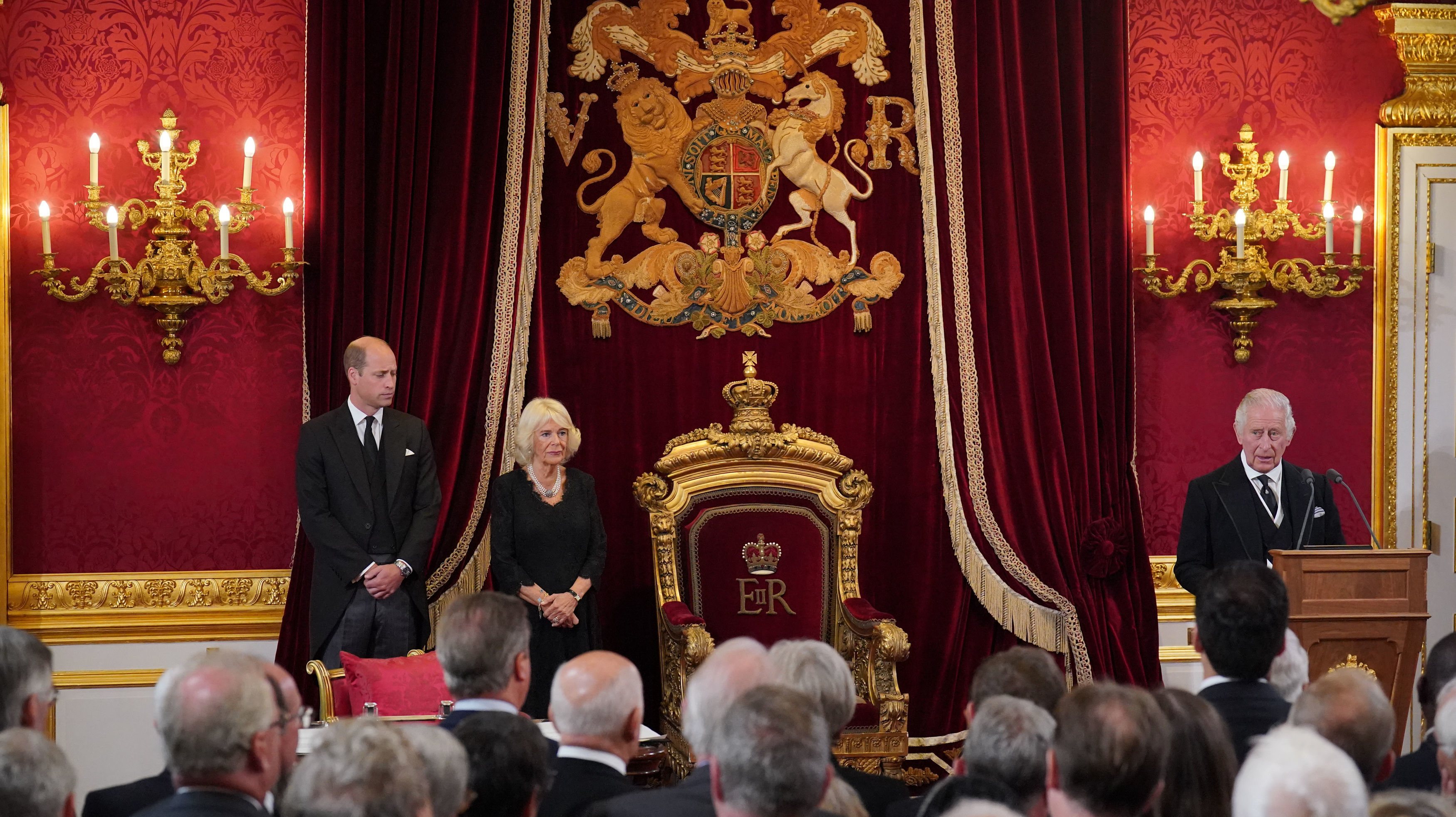29 photos
Charles III was proclaimed king on a busy Saturday morning with two historic ceremonies in London. First in St. James’s Palace and then in the City, there were proclamations, cheers, the national anthem and a declaration from the sovereign. For the first time in history, the Ascension Council ceremony was broadcast on television and allowed the public to follow the monarch’s proclamation, with rituals, traditions and the deployment of the guard.
The date of Elizabeth II’s funeral was also announced for September 19 and the new King declared that day a national holiday. This Sunday the funeral acts of the Queen begin.
From Balmoral to London. The funeral route of Elizabeth II
After the proclamation of Carlos III, the family made appearances to greet the public. While the King remained in London, the new Princes of Wales arrived with the Dukes of Sussex at Windsor. The rest of the royal family close to the King (brothers and nephews) left for a religious service at Balmoral.
The ceremony this morning
Saturday’s celebrations began at St. James’s in London, where the Ascension Council met. This is a ceremonial body that meets after the death of a monarch to formalize the proclamation of the new sovereign. This was thus the first official act in which Charles III participated as King, with William, now Prince of Wales, Camilla, the Queen Consort, Prime Minister Liz Truss, the Archbishop of Canterbury, as well as more than 200 privy councillors, among others. six of them former prime ministers. It was the first time that this ceremony was broadcast on television.
The ceremony began, as British punctuality requires, at 10 a.m. and the dress code He dictated that everyone present wear black. With all the guests gathered in the palace hall, the Ascension Council ceremony began.
Penny Mordaunt, Leader of the House of Commons, began by announcing the death of Queen Elizabeth II with the Queen Consort and the Prince of Wales behind her on a kind of raised stage, facing the audience. She then gave the floor to the secretary of the council, who read the Ascension Proclamation and declared: “Prince Carlos Felipe Artur Jorge is now, at the death of our last sovereign of happy memory, our only legitimate Lord, Carlos III” . At the end, the words “God save the King” were spoken aloud and the proclamation was signed, first by the Queen Consort, followed by the Prince of Wales. Penny Mordaunt returned to the pulpit to read the eight Orders of the Council, then invited those present to accompany her to the Council Chamber, where they would await the King.
The king’s declaration
The second part of the ceremony continued in a room with a throne that still bore the symbol of ER (Elizabeth Regina) and, this time, with the King already present reading a declaration accepting the role of sovereign.
My Lords, Ladies and Gentlemen.
It is my most painful duty to announce the passing of my beloved Mother, the Queen. I know how deeply you, the entire nation, and I think I can say the entire world, sympathizes with me in the irreparable loss we all suffer. It is the greatest comfort to me to know the sympathy expressed by so many towards my sister and brothers and what overwhelming affection and support should be extended to the entire family in our loss.
For all of us as a family, as well as for this kingdom and a great family of nations of which she is a part, my Mother is a lifelong example of selfless love and service. My Mother’s reign was unparalleled in length, dedication and devotion. Even during our pain, we thank you for your life of faithfulness.
I am deeply aware of this great heritage and the weighty duties and responsibilities of the Sovereignty that have now passed to me. In assuming these responsibilities, I will endeavor to follow the inspiring example set before me in upholding constitutional government and seeking peace, harmony and prosperity for the peoples of these islands and the Commonwealth realms and territories throughout the world. world.
In this sense, I know that the affection and loyalty of the peoples that I call to be Sovereigns will support me, and that in the fulfillment of these duties I will be guided by their elected parliaments. In all of this, I am deeply encouraged by the constant support of my loving wife.
I take this opportunity to confirm my willingness and intention to continue the tradition of turning over hereditary income, including Crown property, to my Government for the benefit of all, in exchange for funding from the sovereign, which supports my official duties as Head of State. State and Nation. And in fulfilling this task that has been entrusted to me, and to which I now dedicate the rest of my life, I ask for the guidance and help of Almighty God.”
Charles III then took an oath to keep the Church of Scotland safe and then the King signed two documents confirming the oath and signed as “Charles R”, followed by Prince William, the Queen Consort and Nicola Sturgeon, first – Minister for Scotland.
A series of formal requests from Penny Mordaunt followed, to which the King replied “I approve.” Among them the declaration of the day of Elizabeth II’s funeral as a national holiday throughout the United Kingdom. The Council’s agenda has concluded here.
The proclamation to the balcony
The ceremony then continued in Friary Court, St. James’s Yard, where a number of uniformed guards awaited the king’s proclamation on the porch.
Anticipated by the sound of a series of trumpets, David Vines White, Garter King of Arms, delivered the Principal Proclamation of the new King and declared:
“Prince Carlos Filipe Artur Jorge is now, due to the death of our last sovereign of happy memory, our only legitimate Lord, Carlos III. By the grace of God, of the United Kingdom, of Great Britain and Northern Ireland, and of the other realms and territories, he is King, Head of the Commonwealth, Defender of the Faith, to whom we acknowledge all faith and obedience. with humble affection.”
As the statement ended, White took off his hat, shouted “God save the king,” and the trumpets sounded again. The national anthem followed. Cannon bursts were fired at the same time as the Main Proclamation, 62 at the Tower of London and 41 at Hyde Park. Also at Cardiff Castle, Edinburgh Castle, Gibraltar, Colchester, York, Larkhill (near Stonehenge) and the Devonport and Portsmouth naval bases there were salutes to the new King, the Telegraph reported.
On the balcony of St. James’s Palace were members of the King’s Guard, Coldstream Guards, and eight trumpeters of the Household Cavalry, dressed in gold uniforms bearing the Queen’s (ER) insignia.

A moment of the Main Proclamation, the Palace of Sta. Jaime
In a very special and rare moment, the guards put down their weapons on the ground, took their hats off their heads and placed them on their right shoulders. Then they put their hats in the air to the rhythm of three “hurrahs” to the new king. The guards, who never take off their famous black bearskin hat, took it off as a sign of respect to their new king, so that he could see their faces, in a ritual full of symbolism, explained diplomacy expert Tiago Ferreira Lopes. to CNN Portugal.
The second Proclamation, in the City, London
The second proclamation of Carlos III took place in the center of the City of London at 12:00. In the square in front of the Lonja Real, the building that in the 16th century was the center of commerce in the city. The second proclamation of the new King was made on the steps, before a formation of officers and a series of onlookers who concentrated on the spot. The brief text was read by the officer Clarenceux King of Arms and ended with the declaration “God Save the King”, followed by the sound of a royal salute made with trumpets. The Coldstream Guards band played the national anthem and the ceremony ended with the Lord Mayor of London asking the new King for three cheers.
After the proclamation of the new King, the flags were hoisted again in their entirety for one day. On Sunday, after the proclamation also in Scotland, Northern Ireland and Wales at 12:00, the flags returned to half-staff, as a sign of mourning for Queen Elizabeth II.
After the Proclamation, an afternoon full of apparitions
After the two proclamations, the King and Queen went to Buckingham Palace, London, where, in the afternoon, Charles III met with Prime Minister Liz Truss and members of the Government. The royal couple also had a first audience with Justin Welby, the Archbishop of Canterbury.

The Prince and Duke of Wales and the Duke and Duchess of Sussex at Windsor
In Scotland, after attending a church service at Crathie Kirk near Balmoral Castle, several members of the royal family were viewing tributes to Elizabeth II left outside the property. Princess Anne with her husband and her two children, the Earl and Countess of Wessex (Edward and Sophie), Prince Andrew and his two daughters, Beatrice and Eugenie also greeted the audience that had gathered to see them.
At Windsor, William and Kate made their first appearance together since they were Princes of Wales and alongside the Duke and Duchess of Sussex. The two brothers and two sisters-in-law walked part of the long way to Windsor Castle, where several people gathered to pay their respects.
Charles III passes the baton to his son: the origins and protocol of the investiture of the Prince of Wales
Source: Observadora
